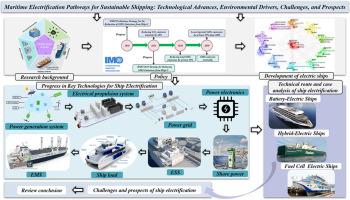Maritime electrification pathways for sustainable shipping: Technological advances, environmental drivers, challenges, and prospects
IF 17
1区 工程技术
Q1 ENERGY & FUELS
引用次数: 0
Abstract
Maritime electrification has gained unprecedented momentum as the shipping industry faces stringent global decarbonization targets and increasingly rigorous International Maritime Organization (IMO) regulations. This review provides a systematic assessment of the technological advances, environmental drivers, challenges, and future prospects of ship electrification, with a focus on three primary pathways: Battery-Electric Ships (BES), Hybrid-Electric Ships (HES), and Fuel Cell Electric Ships (FCES). The analysis encompasses technological maturity levels (TRL), economic competitiveness, lifecycle environmental performance, and regional deployment feasibility. Findings indicate that HES currently dominate commercial applications owing to their operational flexibility and compliance readiness, while BES demonstrate strong potential for short-sea and inland shipping routes, and FCES represent a long-term solution for deep decarbonization provided that green hydrogen and ammonia infrastructure becomes available. The review highlights persistent barriers, including limited energy density for large vessels, insufficient megawatt-scale charging and refueling infrastructure, durability and reliability concerns under harsh marine conditions, and misaligned global policy frameworks. Notable contributions include the provision of quantitative TRL evaluations for BES, HES, and FCES, a comparative analysis of regional deployment strategies targeting emission-intensive maritime zones, and the identification of AI-enabled digital twin technologies as a promising approach to optimize energy management and fleet operations. To accelerate maritime electrification, future research is directed toward breakthroughs in solid-state batteries, advanced corrosion-resistant materials, safe and efficient hydrogen/ammonia storage, port-level renewable microgrids, and standardized international safety regulations. Overall, this review establishes a comprehensive roadmap for academia, industry stakeholders, and policymakers to advance the transition toward sustainable, zero-emission shipping.

可持续航运的海上电气化途径:技术进步、环境驱动因素、挑战和前景
随着航运业面临严格的全球脱碳目标和国际海事组织(IMO)日益严格的规定,海上电气化获得了前所未有的动力。本文对船舶电气化的技术进步、环境驱动因素、挑战和未来前景进行了系统评估,重点介绍了三种主要途径:电池电动船舶(BES)、混合动力电动船舶(HES)和燃料电池电动船舶(FCES)。分析包括技术成熟度水平(TRL)、经济竞争力、生命周期环境绩效和区域部署可行性。研究结果表明,由于其操作灵活性和合规性,HES目前在商业应用中占主导地位,而BES在短途和内陆航线上显示出强大的潜力,而FCES则代表了深度脱碳的长期解决方案,前提是绿色氢和氨基础设施可用。该评估强调了持续存在的障碍,包括大型船舶的能量密度有限,兆瓦级充电和加油基础设施不足,恶劣海洋条件下的耐久性和可靠性问题,以及不一致的全球政策框架。值得注意的贡献包括为BES、HES和FCES提供定量TRL评估,对针对排放密集型海域的区域部署策略进行比较分析,以及将人工智能支持的数字孪生技术确定为优化能源管理和船队运营的有前途的方法。为了加速海上电气化,未来的研究方向是在固态电池、先进的耐腐蚀材料、安全高效的氢/氨储存、港口级可再生微电网以及标准化的国际安全法规方面取得突破。总体而言,本综述为学术界、行业利益相关者和政策制定者制定了全面的路线图,以推进向可持续、零排放航运的过渡。
本文章由计算机程序翻译,如有差异,请以英文原文为准。
求助全文
约1分钟内获得全文
求助全文
来源期刊

Etransportation
Engineering-Automotive Engineering
CiteScore
19.80
自引率
12.60%
发文量
57
审稿时长
39 days
期刊介绍:
eTransportation is a scholarly journal that aims to advance knowledge in the field of electric transportation. It focuses on all modes of transportation that utilize electricity as their primary source of energy, including electric vehicles, trains, ships, and aircraft. The journal covers all stages of research, development, and testing of new technologies, systems, and devices related to electrical transportation.
The journal welcomes the use of simulation and analysis tools at the system, transport, or device level. Its primary emphasis is on the study of the electrical and electronic aspects of transportation systems. However, it also considers research on mechanical parts or subsystems of vehicles if there is a clear interaction with electrical or electronic equipment.
Please note that this journal excludes other aspects such as sociological, political, regulatory, or environmental factors from its scope.
 求助内容:
求助内容: 应助结果提醒方式:
应助结果提醒方式:


